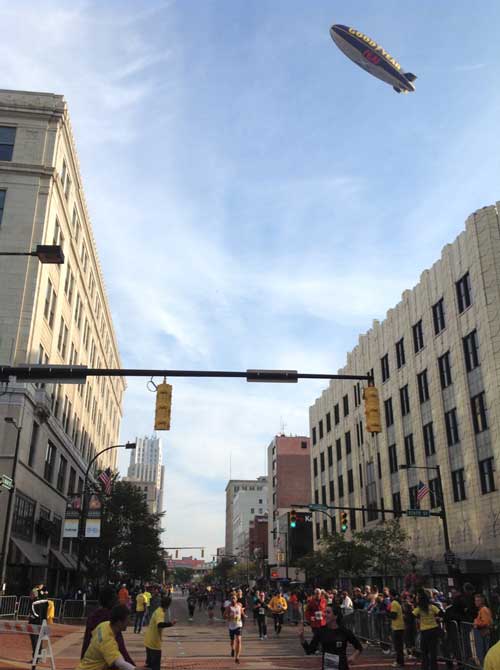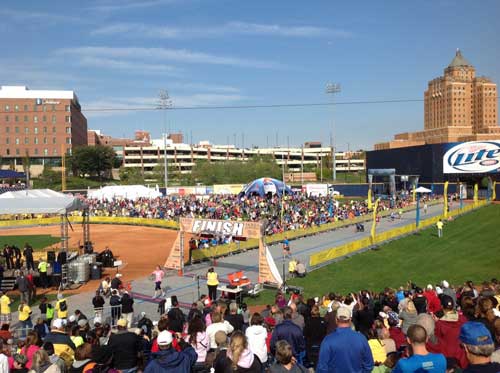I visited the Akron Marathon in 2002, its first year and enjoyed the enthusiasm and interest in growing the city through running. Dave Hunter has provided this weeks column on his favorite city, the Akron Marathon, which he has witnessed grow like few others.
A Glorious 10th Running
Akron Marathon Displays Ideal Template
For Mid-Major Marathons
RelatedPosts
September 30, 2012
There’s an old expression, “I’d rather be lucky than good.” On Saturday — as it celebrated its 10th running — the Akron Marathon showed that it has become both.
Good fortune came into play as Race Day dawned — once again — under absolutely perfect weather conditions. Dry, windless 42-degree temperatures with dropping humidity readings greeted the 15,000+ runners who were eager to take on the newly-modified — and faster — race course.
Favorable weather and the faster track combined to produce impressive times. In the men’s marathon, Richard Kessio threw in a decisive surge at Mile 20 to break free as he unfurled a withering race-ending push — his quest to post a new event record. A packed throng of 9100  fans roared encouragement to Kessio — now in full flight — as he burst through the outfield entry and into Canal Park for the final 80 meter drive to the line. Running under the finish clock in 2:18:51, the winner just missed Charles Kamindo’s 7-year old event record by a mere 3 seconds, but nonetheless became only the fourth runner to break 2:20 at Akron. On the women’s side, Shanna Ailes Istnick overtook the struggling Becki Michael — the defending champion — at the 21 mile mark to breeze on to an easy 2:55:09 victory. New event records were also posted in the men’s and women’s 5-person relay — Akron boasts the largest marathon relay field in the country — and in the men’s Masters half and full marathon races. By once again lowering his own event record in capturing the men’s Masters marathon crown with a sparkling time of 2:28:24, 44-year old Sergey Kaledin will see his name engraved on the Brouse Cup for the fourth time.
fans roared encouragement to Kessio — now in full flight — as he burst through the outfield entry and into Canal Park for the final 80 meter drive to the line. Running under the finish clock in 2:18:51, the winner just missed Charles Kamindo’s 7-year old event record by a mere 3 seconds, but nonetheless became only the fourth runner to break 2:20 at Akron. On the women’s side, Shanna Ailes Istnick overtook the struggling Becki Michael — the defending champion — at the 21 mile mark to breeze on to an easy 2:55:09 victory. New event records were also posted in the men’s and women’s 5-person relay — Akron boasts the largest marathon relay field in the country — and in the men’s Masters half and full marathon races. By once again lowering his own event record in capturing the men’s Masters marathon crown with a sparkling time of 2:28:24, 44-year old Sergey Kaledin will see his name engraved on the Brouse Cup for the fourth time.
Looking back on its first decade, the Akron Marathon knows it has come a long way from its inaugural running in which 3500+ runners competed. Akron understands that it will never become an overpowering and far-reaching urban marathon — like a Boston, a New York, a Chicago. That’s OK — race organizers have never really aspired to become that type of event. The Akron Marathon — growing every year to its present level of 15,000+ participants — is now a “mid-major” marathon that is comfortable in its own skin. Without the revered heritage, the international flavor, or the destination hook, Akron has promoted and refined as its mantra an observation first enunciated by Bill Rodgers who observed, “Akron treats every runner as a world-class athlete.”
 Runners prepare to turn into ball park for final 150 meters of the race.
Runners prepare to turn into ball park for final 150 meters of the race.Like a good many marathons throughout the country, Akron appreciated early on that the event that is “the marathon weekend” has evolved into more than a one-dimensional athletic contest attracting mainly a narrow group of uber-fit — and often eclectic — elite distance runners. Those high-performing runners are now joined by a broader-base of marathon participants: the regional stars; the post-collegiate athletes; the recreational runners; the suburban yuppies who place a premium on wellness and stress relief; the aging boomers who seek healthier lifestyles to elevate the quality of life and to soften the inevitable aging process; and, yes, even the office-bound weekend warriors who seek a lark from the tedium of their all-consuming work schedules. Akron has always seen its marathon weekend as “a big tent” — with room for all.
But a city’s cultivation of a successful marathon weekend can bring ancillary benefits as well. And, in the case of Akron, most of those types of benefits were anticipated, targeted, and rolled into the race’s strategic planning process.
From the beginning, Akron has been cognizant of the potential for its race weekend to boost the economic fortunes of its greater regional area. A 2010 economic impact study undertaken by the University of Akron revealed that the economic impact of the Akron Marathon — essentially a two-day event — was $4.0 million. A similar study analyzing the following year showed that the Akron event — aided by the growth in its number of participants and by the improving economy — conferred upon the region a positive economic impact of $5.25 million. Aware of the record number of its 2012 entrants, race leadership — indeed the entire city — is confident that the economic impact for this year will continue the economic impact trend of up and to the right.
The health benefits which can result from a sensibly-assembled personal program of aerobic exercise and a varied and nutritionally-sound diet can be yet an additional positive bi-product of a region’s development of its own, home-grown marathon. While access to affirming hard data from the Akron area is still likely years away, anecdotal observations [e.g. increased patronage of the region’s Cuyahoga Valley National Park; more area residents running, cycling, joining health clubs; an encouraging drop in health care costs for area employers who promote and reward employee wellness; notable progress in constraining the growth of childhood obesity;] tend to confirm yet another important ancillary benefit which can emerge when a successful marathon weekend is one of a city’s assets.
But there is yet a final related benefit that Akron did not originally grasp, but has been captured by the city nonetheless. And that is the power that a marathon weekend has to capture the imagination of a city, to inspire and galvanize its citizenry, even to heal its wounds. The marathon is in no way constrained by socio-economic boundaries. When you lace up your Nikes — to train for the big race or to go to the line on race day — the marathon cares not if you are young or old, rich or poor, male or female, black or white. It asks only one question of those who would take up its challenge: are you ready to look deep inside and learn about yourself today? It is a personal journey — a race against others, to be sure; but also a competition with you alone. And anyone who has watched marathon finishers inside Canal Park can give testimony to the unending stream of distinctly personal victories that can be observed there — the exuberant athlete setting that long-chased PR; the exhausted mid-packer quietly savoring the personal goal of merely finishing; the tearful runner finishing the race in honor of an ill or lost loved one.
 Olympic style finish in Canal Park – our 9100-seat HOK minor league ball park.
Olympic style finish in Canal Park – our 9100-seat HOK minor league ball park.In Akron, marathon weekend has even healed its residents. Several years ago, the city suffered through a divisive mayoral recall election — an agonizing campaign that distracted the town from its core issues and ultimately failed by a wide margin. Several weeks later, after that early-September election day, the annual running of the Akron Marathon turned out to be just the festive and inclusive event that allowed its people to begin the healing process.
In the beginning, the economic impact boost and the heightened wellness level were strategic initiatives identified and targeted with relative ease by the race’s staff and its Board. And now, over the last decade, the less-obvious ability of a city’s successful marathon weekend to empower, to inspire, even to heal its people — not initiall
y accorded enough importance by Akron’s race leadership — is now more fully appreciated. And, in the final analysis, more thorough cultivation of that unique power may lead to the most important benefits of all.
~Dave Hunter





















